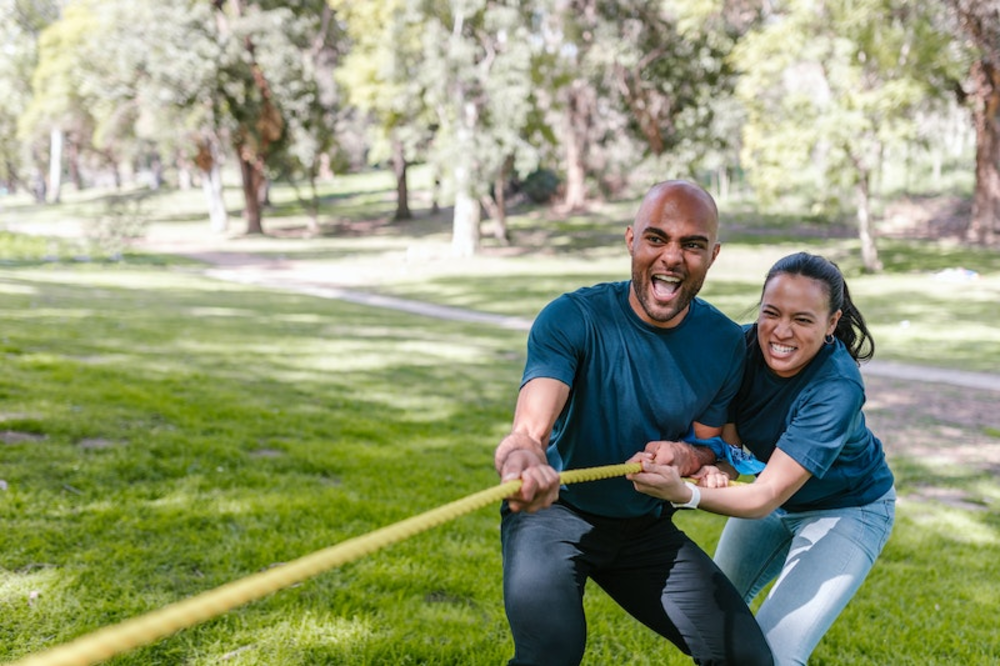In today’s fast-paced world, finding time to stay physically active can be a challenge. As a personal trainer, you understand the importance of maintaining a consistent workout routine despite a busy life.
You know that even a short, focused workout session can make a big difference in your client’s well-being.
This article will discuss various strategies and exercises to help you create effective workout routines for busy schedules.
Understanding Time Constraints
Before you plan a workout plan for busy people, it’s crucial to identify their specific time limitations. Let’s go into detail on this.
Identifying Clients’ Specific Time Limitations

As a personal trainer, it’s important to understand your client’s unique time constraints to tailor their workout plans effectively.
Start by discussing their daily routines and responsibilities to pinpoint when they can realistically fit in their workouts.
Some clients may only have 30 minutes before work, while others might have a longer window during their lunch break or in the evenings.
Prioritizing Exercise Goals Based on Available Time

Once you have identified your clients’ time constraints, work with them to prioritize their fitness goals.
This process can help create a more focused workout plan that targets their primary objectives.
For example, if a client has only 20 minutes per day to exercise, you may prioritize high-intensity workouts that maximize calorie burn and improve cardiovascular health.
Alternatively, if a client has more time available, you could incorporate strength training and flexibility exercises.
Balancing Exercise Frequency, Intensity, and Duration

When creating workout plans for clients with limited time, it’s essential to strike a balance between exercise frequency, intensity, and duration.
For example, if a client can only work out three times per week, consider increasing the intensity of their sessions to ensure they still achieve their fitness goals.
On the other hand, if a client can exercise more frequently but has limited time per session, you may need to focus on shorter, more targeted workouts.
Setting Realistic Expectations
Help clients set realistic expectations regarding their fitness goals based on their available time.
Communicate the importance of consistency and gradual progress, emphasizing that even small increments of exercise can make a difference in their overall health and well-being.
Encourage clients to celebrate their achievements, no matter how small, and remind them that staying active despite a busy schedule is an accomplishment in itself.
Time-Efficient Workout Plans For Busy Schedules

1. High-Intensity Interval Training (HIIT)
High-intensity interval training (HIIT) is an excellent choice for clients with a busy schedule.
This workout method involves alternating between intense bursts of physical activity and brief recovery periods.
The benefits of HIIT include burning more calories in less time, boosting metabolism, and improving cardiovascular health.
Example HIIT Workout
- Warm-up: 3 minutes of light jogging or dynamic stretching
- Exercise 1: 30 seconds of burpees
- Rest: 30 seconds
- Exercise 2: 30 seconds of push-ups
- Rest: 30 seconds
- Exercise 3: 30 seconds of jump squats
- Rest: 30 seconds
- Exercise 4: 30 seconds of mountain climbers
- Rest: 30 seconds
- Exercise 5: 30 seconds of plank jacks
- Rest: 30 seconds
- Repeat the circuit 2-3 times
- Cool-down: 3 minutes of stretching
2. Circuit Training
Circuit training is another time-efficient workout method that keeps muscles working and heart rate elevated. In this type of training, clients perform a series of exercises with minimal rest in between.
Circuit training can include both body weight exercises and resistance training with weights or resistance bands.
Example Circuit Training Workout:
- Warm-up: 3 minutes of light jogging or dynamic stretching
- Exercise 1: 45 seconds of goblet squats (with dumbbell or kettlebell)
- Rest: 15 seconds
- Exercise 2: 45 seconds of dumbbell rows
- Rest: 15 seconds
- Exercise 3: 45 seconds of push-ups
- Rest: 15 seconds
- Exercise 4: 45 seconds of alternating reverse lunges
- Rest: 15 seconds
- Exercise 5: 45 seconds of Russian twists (with or without weight)
- Rest: 15 seconds
- Repeat the circuit 2-3 times
- Cool-down: 3 minutes of stretching
3. Tabata Training
Tabata training is a form of HIIT that focuses on very short, intense intervals of exercise followed by brief rest periods.
This method can provide an excellent workout in as little as four minutes, making it ideal for clients with a tight schedule.
Example Tabata Workout:
- Warm-up: 3 minutes of light jogging or dynamic stretching
- Exercise 1: 20 seconds of burpees
- Rest: 10 seconds
- Exercise 2: 20 seconds of push-ups
- Rest: 10 seconds
- Exercise 3: 20 seconds of bicycle crunches
- Rest: 10 seconds
- Exercise 4: 20 seconds of jump squats
- Rest: 10 seconds
- Repeat the circuit 2 times
- Cool-down: 3 minutes of stretching
4. Super-Set Training
Super-set training involves performing two exercises back-to-back with little to no rest in between.
This method not only saves time but also increases the intensity of the workout, helping clients reach their fitness goals faster.
Example Super-Set Workout:
Warm-up: 3 minutes of light jogging or dynamic stretching
- Exercise 1: 10-12 bench presses
- Exercise 2: 10-12 bent-over rows
- Rest: 30-60 seconds
- Exercise 3: 10-12 bicep curls
- Exercise 4: 10-12 tricep dips
- Rest: 30-60 seconds
- Repeat the super-set 2-3 times
- Cool-down: 3 minutes of stretching
5. Full-Body Bodyweight Workout
- Warm-up: 3 minutes of light jogging or dynamic stretching
- Exercise 1: 10-12 push-ups
- Rest: 30 seconds
- Exercise 2: 10-12 bodyweight squats
- Rest: 30 seconds
- Exercise 3: 10-12 tricep dips using a chair or bench
- Rest: 30 seconds
- Exercise 4: 10-12 reverse lunges per leg
- Rest: 30 seconds
- Exercise 5: 30-second plank
- Rest: 30 seconds
- Repeat the circuit 2-3 times
- Cool-down: 3 minutes of stretching
Remember, the workouts provided are just examples. Factors such as fitness level, experience, and any limitations or injuries should be taken into account when creating a personalized plan for your clients.
Adapting Workouts for Different Environments

It’s essential to design versatile workouts that can be performed in various settings, such as at home, at the gym, or outdoors.
This flexibility helps clients stick to their workout routines regardless of their circumstances or access to equipment.
At-Home Workouts
Suggest bodyweight exercises and household items as makeshift workout equipment.
Encourage clients to follow workout challenges or fitness apps for guidance and motivation.
Gym Workouts
Help clients familiarize themselves with gym equipment and create gym-specific workout plans.
Encourage off-peak hour visits and teach proper gym etiquette and safety measures.
Outdoor Workouts
Suggest nearby parks, trails, or open spaces for outdoor workouts.
Include exercises that utilize the natural environment and encourage clients to connect with nature.
Travel Workouts
Create travel-friendly workout plans that can be performed in small spaces.
Suggest portable workout equipment and bodyweight exercises or HIIT workouts.
Adapting to Available Equipment
Teach clients how to modify exercises based on available equipment.
Provide alternative exercises that target the same muscle groups.
By providing clients with adaptable workout plans and teaching them how to adjust exercises for different environments, you empower them to maintain consistency in their fitness journey, fostering a sustainable commitment to health and fitness.
The Role of Nutrition and Recovery
Nutrition and personal training go hand in hand. Educate your clients about pre-and post-workout meals that fuel the body and aid in recovery.
Emphasize the importance of adequate rest and recovery time to prevent injury and support overall health.
Effective Time Management Strategies
- Schedule workouts in advance: Encourage clients to plan their workouts for the week and add them to their calendars, making exercise a non-negotiable priority.
- Break workouts into smaller segments: If clients struggle to find a solid block of time, suggest breaking workouts into smaller 10-15 minute segments throughout the day.
- Utilize lunch breaks or short breaks: Encourage clients to incorporate short workouts, like a brisk walk or bodyweight exercises, during lunch breaks or other short breaks throughout the day.
- Emphasize efficiency: Guide clients towards high-intensity, full-body workouts that target multiple muscle groups in a shorter time.
- Make workouts enjoyable: Help clients find workouts they enjoy, such as online fitness challenges increasing the likelihood they will prioritize and stick to their exercise routine.
- Keep track of progress: Track progress with a fitness journal or fitness app to stay accountable and motivated.
Conclusion
As a fitness professional, you play a key role in helping clients navigate the challenges of maintaining a workout routine amidst a busy life.
By understanding their time constraints, employing efficient workouts like HIIT, and promoting proper nutrition and recovery, you can help your clients stay on track and achieve their fitness goals.




